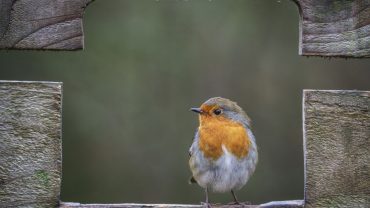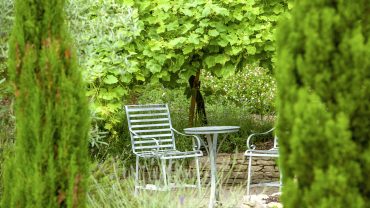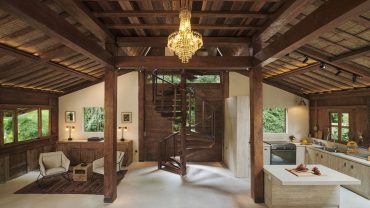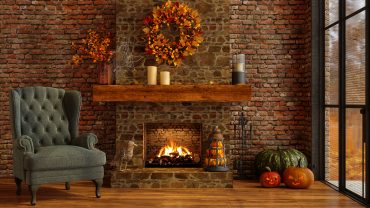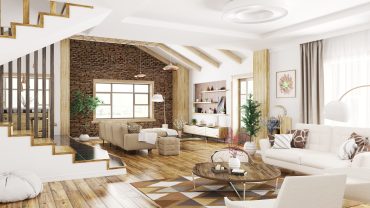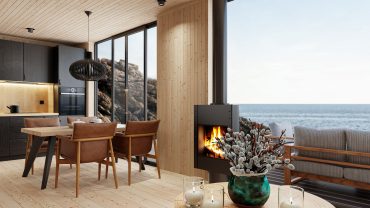Often characterised by its rustic and cosy charm, farmhouse interior design originates from the practical and straightforward approach of life on a farm. It’s a style that combines comfort with functionality, blending old and new elements to create a warm, welcoming space.
So, what is farmhouse interior design? From traditional to modern farmhouse decor and the elements of a farmhouse kitchen, we’re ploughing into it all.
A History of Farmhouse Interior Design

Vintage farmhouse table in rustic kitchen (Credit: Andreas von Einsiedel via Getty Images)
Farmhouse decor has something of an organic history. Some say it dates back to early settlers in North America bringing with them ideas from Europe, sometimes ascribing Scandinavian or German influences. Whatever the case, there seems to be a consensus that the origins of farmhouse design stemmed not from aesthetics, but from the realities of rural life and how they translated into the architecture and interiors of farmers’ homes.
The characteristics of functionality, practicality and durability have endured as central tenets of farmhouse design but with an increased emphasis on visual appeal and the incorporation of modern amenities. Now, let’s look at how this comes together into a cohesive interior design movement.
What is Farmhouse Interior Design?

Country house in the Cotswolds with a farmhouse interior design theme. (Credit: Andreas von Einsiedel via Getty Images)
Farmhouse style is often described using sweeping adjectives such as cosy, warm, and simple. Nevertheless, while there’s no definitive list of criteria to achieve this look, we can identify key elements which have become hallmarks of this school of design.
Natural materials and colours
Just as the construction of historic farmhouses depended on what materials were readily available, farmhouse decor favours natural, locally sourced, rustic options like reclaimed wood, wrought iron, and natural stone. This approach also affects colour choices, which tend towards a natural palette typically revolving around soft whites, creams, and earthy tones, creating a soothing and inviting space.
Functional fashion
When farmhouse interior design is lauded for its simplicity and cosiness, this derives, in large part, from its focus on utilitarian concerns. Every item serves a function. Thus, seating should be comfortable, tables big enough to seat a crowd, and decor minimal. What’s more, the specific features usually found in farmhouse interiors are based on elements that were once vital for day-to-day life. For example:
Large fireplaces: A vital heat source at the heart of farmhouses past, they’re an added bonus in those of the present.
Stable doors: Favoured for the flexibility of separate top and bottom opening, they kept animals out while having the option to let air in. Barn doors are another excellent farmhouse touch, especially given their space-saving potential.
Wood Ceiling Beams: Once there to keep the house standing, nowadays they’re often purely a style statement.
Upcycling in Farmhouse Decor
From revamped second-hand furniture to repurposed barn doors, these elements add a unique and authentic touch to farmhouse decor, reflecting the style’s emphasis on practicality and resourcefulness.
Authentic touches
Vintage items are a staple of farmhouse interior design. Accessories like wrought iron lighting fixtures, hand-woven rugs, and vintage artwork play a significant role in adding character and charm. These details, though small, can profoundly impact the overall ambiance of a farmhouse-styled home.
Modern Farmhouse Decor

A modern kitchen room with green island and a farmhouse sink. (Credit: alabn via Getty Images)
Modern farmhouse decor is a blend of traditional country elements with a contemporary twist. It involves maintaining the cosy, rustic vibe while infusing modern touches like clean lines, minimalist decor, and updated materials, providing a fresh take on the classic farmhouse style.
Some might describe modern farmhouse design as a pared back version of the classic genre. So, rather than being infused into every aspect of the house, it might be incorporated into the colour scheme, a few statement furniture pieces or distinctive architectural elements.
And there’s no talking of modern farmhouse decor without mentioning shiplap. Popularised by HGTV’s own Fixer Upper, hosts Chip and Joanna Gaines were instrumental in bringing this wall panelling to the farmhouse fore. Usually made up of overlapping horizontal wooden boards, they were originally used in ships for their waterproof capabilities. Like other forms of panels, they were historically used in homes as a way to protect the walls. Nowadays they’re an essential part of the modern farmhouse aesthetic.
Farmhouse Kitchen Decor

Open plan kitchen and dining room, decorated with a farmhouse theme. (Credit: Andreas von Einsiedel via Getty Images)
Farmhouse kitchen decor is a genre all of its own. Indeed one might find a farmhouse kitchen in an otherwise differently styled home. The usual farmhouse interior design rules apply, including neutral tones and a vintage feel by way of shaker style cupboards, knick knacks on display, and distressed metals such as copper or bronze. But, for some very practical reasons, a farmhouse style is also amplified in a kitchen setting. For one thing, plumbing is a relatively 20th century addition to homes, meaning the sink in the traditional farm home had to hold all the well water one could conceivably carry. Oversized Belfast sinks are the way to go for an authentic look, especially as they’re also super practical.
Other popular additions to a farmhouse kitchen include butcher block countertops, range cookers, enormous dressers, and large rustic wooden dining tables.
Embracing Farmhouse Decor

An elegant farmhouse bedroom with beams and large windows overlooking garden. (Credit: JulieanneBirch via Getty Images)
The enduring appeal of farmhouse interior design lies in its ability to evoke a sense of comfort and nostalgia. Whether through a complete overhaul or subtle touches, incorporating farmhouse elements can transform a space into a warm, inviting home. As a versatile and adaptable style, it encourages personal expression and creativity.

